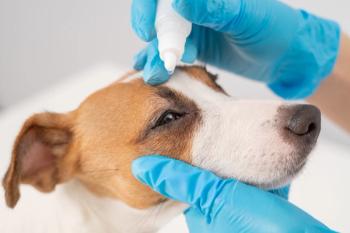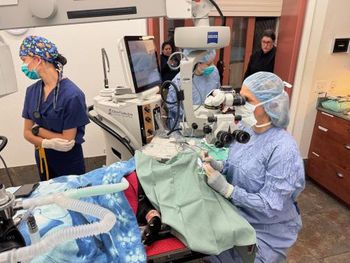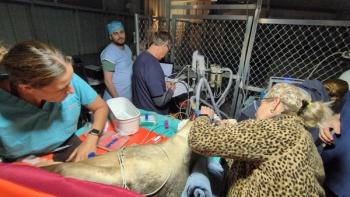
Canine ocular manifestations of systemic disease: when the primary problem isn't the eye (Proceedings)
Complete medical history
• Complete medical history
o Weight loss, anorexia, vomiting, diarrhea, animals environment (exposure to other animals, mycotic organisms), travel history
• Complete physical examination
• Bloods: CBC/ Chem /T4 /Serology
• Radiographs – Thoracic for mycotic, neoplastic conditions
Etiologies
• Infectious
o Bacterial, Viral, Fungal, Rickettsial, Protozoal, Parasitic, Algal
• Metabolic/Circulatory
o Diabetes, Thyroid diseases, Hypertension
• Neoplastic
o Lymphoma, metastatic tumors
• Toxic
o Drugs, nutritional disorders
• Immune-Mediated
• Uveodermatologic syndrome
Uveitis- differential diagnosis
Infectious
• Fungal
o Blastomycosis
o Histoplasmosis
o Cryptococcus
o Coccidiomycosis
o Candidiasis
• Viral
o FeLV/ FIV
o FIP
o Canine Distemper
o Adenovirus
• Algal (prototheca)
• Bacterial
o Brucellosis
o Bartonella
o Babesia
• Protozoal
o Toxoplasmosis
o Leishmaniasis
• Rickettsial
o Ehrlichia
o RMSF
• Parasitic
o Dirofilaria
o Toxocara
Uveitis- differential diagnosis
• Immune Mediated
o Uveodermatologic syndrome
o ERU
o Lens –induced (phacolytic)
• Traumatic
o Lens capsule rupture
o Blunt trauma
o Penetrating trauma
• Toxic
• Neoplastic
o Lymphoma
o Melanoma
• Metabolic
o Systemic hypertension
o Hyperlipidemia
• Idiopathic
Blastomycosis
• Blastomyces dermatitidis
o dimorphic fungi
• In soil a saprophytic mycelial form
o producing infective spores (conidia)
• In tissues is a budding yeast 5-20 um
o thick double contoured wall
• Endemic to various river valleys
o North America-"Blasto Belt".
Blastomycosis
• Establishes in lungs (inhalation)
o disseminates via lymph nodes or blood to skin, eyes, bones, lymph nodes, brain & testicles.
• Lymphadenopathy, fever, harsh lung sounds, draining skin lesions, cough, & emaciation
• Blastomycosis - Treatment
• Itraconazole
• Fluconazole
• Ketoconazole
• Amphotercin B
• Topical / Systemic Corticosteriods
Coccidiomycosis
Cryptococcus
• Diagnosis
o Cytologic – India ink, Gram's stain, Wright's stain
• cerebral spinal fluid, vitreous humor
• CSF: neutrophilic pleocytosis, increased protein, organisms seen in 60% of positive samples.
o Cryptococcal capsular antigen test
• using latex agglutination from serum or CSF
o Fungal culture
o Usually poor prognosis for dogs
Histoplasmosis
• Dimorpic fungus Histoplasma capsulatum
o soil saprophyte.
• Life cycle similar to blasto and coccidiomycosis
• Ocular lesions not as severe as other fungi
• Most infections are subclinical respiratory infections
• If disseminated
o digestive tract & reticuloendothelial system
• Anterior uveitis
o pyogranulomatous multi-focal to coalescing lesions
• Optic neuritis
• Retinal detachment
Toxoplasmosis
• Obligate intracellular protozoal parasite
• Felines are the only known definitive hosts
• Three infective stages of T gondii recognized:
• 1) tachyzoites (the rapidly multiplying form)
• 2) bradyzoites (tissue cyst form)
• 3) sporozoites (within oocysts).
• Anterior uveitis, retinitis, & choroiditis
• Less common lesions
• extraocular myositis & optic neuritis
Erlichiosis
• Ehrlichia canis
• Tick vector
• Three disease stages:
• 1) acute (1-3 wks),
• 2) subclinical (average of 11 wks)
• 3) chronic
• Platelet deficiency, vasculitis (or both)
• Ocular hemorrhages and mucosal petechial hemorrhages
• Natural infection :10-15% have ocular lesions
• Ocular signs may be present in all stages
• Anterior uveitis
• Optic nerve may be inflammed and retinal vessels may seem engorged with perivascular infiltrates and papillary hemorrhages
• Retinal hemorrhages common and retinal detachments occur with exudates
RMSF
• Rickettsia rickettsii – similar ocular lesions to Ehrlichia canis, but milder.
• Tick born
• Conjunctivitis, chemosis, retinal vasculitis, mild anterior uveitis, petechiation
• Systemic thrombocytopenia, anemia, vasculitis, arthritis
Lyme disease
• Borrelia burgorferi
• Clinical cause of uveitis in dogs
• Tick born
• Treatment:
o Doxycycline
• Prevention
o Tick repellants
o Vaccination?
Canine lymphosarcoma
• Most common metastatic neoplasia to the canine eye & cause for neoplastic uveitis in dogs.
• Usually bilateral anterior uveitis
• Also common
o Posterior uveitis, retinal infiltrates &detachment
• Thickened third eyelids
• Diagnosis
o Lymph Node biopsy
o Splenic/liver aspirate
Diabetes mellitus
• Young dogs-most susceptible to developing cataracts
• Rare in cats
• Increased blood sugar overwhelms hexokinase
o Polyols are formed & accumulate in the lens
o Resulting in an osmotic gradient
• Rapidly developing cataracts (within 72 hrs)
o often have deep clefts.
Diabetes mellitus
• Evaluate blood glucose and blood fructosamine
• Prior to surgery –
o control accompanying uveitis
o perform an electroretinogram and ocular ultrasonography
• Post-op inflammation control is necessary
o oral and topical nonsteroidals.
o May need treatment for 2 or more months.
Uveo-dermatologic syndrome
• An immune-mediated condition
o poliosis, vitiligo, & severe bilateral uveitis.
o Akitas, Siberian Huskies, & Samoyeds.
• Severe uveitis, blindness, retinal detachment & glaucoma
• Depigmentation of eyelids, lips and nose.
• No specific diagnostic test
o Classic clinical signs and breed.
• Systemic oral corticosteroids & azathioprine
o azathioprine takes up to 4 weeks to become effective
o Monitor WBC count and liver enzymes carefully
• Topical prednisolone
Sudden acquired retinal degeneration
• A syndrome of acute blindness of unknown etiology.
• Acute vision loss
o Initially ± retinal degenerative changes
o Over time the retina will exhibit gross degenerative changes.
• Absent pupillary light responses
• Diagnostics
o Electroretinogram (ERG) wave form is extinguished
o Rule out Cushings Disease
• Therapy
o No therapy to date to reverse blindness.
o Treat for Cushing's if indicated.
• Unfortunately, vision loss is almost always permanent.
Hypertensive retinopathy
• Occurs in both dogs and cats much more commonly in cats
• Ocular-most common findings are hyphema and retinal detachment
o Fundus exam often reveals tortuous vessels, retinal hemorrhages & focal degeneration
• Systolic readings greater than 160-180 mmHg
• Treatment
o Amlodipine 0.625mg orally daily
o Topical antiinflammatories (steroidal and nonsteroidal) oral antihypertensive medication,
o oral dichlorphenamide (Daranide® 1-2 mg/lb PO BID for up to 30 days) for its effect on improving the chance for retinal reattachment.
• Prognosis – dependent upon time of detachment
Feline infectious diseases
• Feline Leukemia Virus
• Feline Immunodeficiency Virus
• Feline Infectious Peritonitis
• Feline Herpesvirus
• Systemic Fungal Diseases
• Toxoplasmosis
Feline immunodeficiency virus
• Systemic
o Lymphoma
o Immunosuppression
• leukopenia, lymphopenia, anemia, weight loss, persistent diarrhea, opportunistic & secondary infections
o Coinfection
• Chlamydia psittaci prolonged infection
• Toxoplasma gondii increased severity
• Ocular
o Usually due to lymphosarcoma
o Pars planitis, retinopathy, conjunctivitis, orbital disease
Feline infectious peritonitis
• Clinical Signs-Systemic
o Anorexia, weight loss, lethargy, mild fever, mild URI or intestinal signs
o EFFUSIVE
• Ascites, thoracic effusion, pericardial effusion, abdominal masses (adhesions or mesenteric lymphadenopathy)
o NON-EFFUSIVE
• Granulomatous lesions in spleen, liver, kidney, omentum, lungs and/or LNs
• Typically develop ocular signs
• May develop CNS signs
Feline infectious peritonitis
• Clinical Signs-Ocular
o Anterior and posterior uveitis
o Bilateral granulomatous anterior uveitis with chorioretinitis
o "Mutton-fat" keratic precipitates
o Secondary glaucoma, cataract formation, lens luxation
Feline herpesvirus
• Acute and Chronic FHV-1
o Initially colonizes the oral and naso-pharyngeal mucosa and conjunctiva
o Corneal ulceration occurs with viral replication in corneal epithelium
o Stromal keratitis with deep neovascularization occurs with immune response to viral antigen
• Latent FHV-1
o Virus localizes in trigeminal ganglion, can migrate down trigeminal nerves to cornea and conjunctiva
Feline herpes virus clinical signs
• Systemic
o Upper respiratory infection with fever, lethargy, inappetence
• Ocular
o Conjunctivitis with serous to purulent discharge
o Corneal ulceration (dendritic, Rose Bengal +)
o Symblepharon
o Stromal keratitis
o Sequestra
o Possible anterior uveitis
Feline herpesvirus therapy
o Topical antivirals:
• Idoxuridine
• Vidarabine (Vira-A®)
• Trifluridine (Viroptic®)
o Topical antibiotics for secondary ocular infections
o L-lysine 250-500mg PO BID
Newsletter
From exam room tips to practice management insights, get trusted veterinary news delivered straight to your inbox—subscribe to dvm360.




